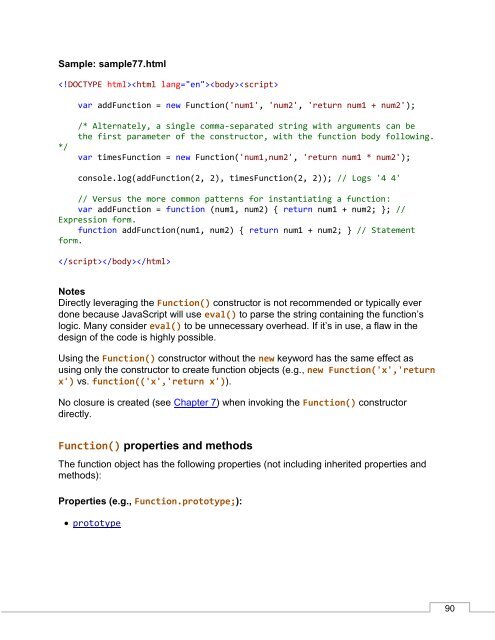JavaScript_Succinctly
Create successful ePaper yourself
Turn your PDF publications into a flip-book with our unique Google optimized e-Paper software.
Sample: sample77.html<br />
<br />
var addFunction = new Function('num1', 'num2', 'return num1 + num2');<br />
*/<br />
/* Alternately, a single comma-separated string with arguments can be<br />
the first parameter of the constructor, with the function body following.<br />
var timesFunction = new Function('num1,num2', 'return num1 * num2');<br />
console.log(addFunction(2, 2), timesFunction(2, 2)); // Logs '4 4'<br />
// Versus the more common patterns for instantiating a function:<br />
var addFunction = function (num1, num2) { return num1 + num2; }; //<br />
Expression form.<br />
function addFunction(num1, num2) { return num1 + num2; } // Statement<br />
form.<br />
<br />
Notes<br />
Directly leveraging the Function() constructor is not recommended or typically ever<br />
done because <strong>JavaScript</strong> will use eval() to parse the string containing the function’s<br />
logic. Many consider eval() to be unnecessary overhead. If it’s in use, a flaw in the<br />
design of the code is highly possible.<br />
Using the Function() constructor without the new keyword has the same effect as<br />
using only the constructor to create function objects (e.g., new Function('x','return<br />
x') vs. function(('x','return x')).<br />
No closure is created (see Chapter 7) when invoking the Function() constructor<br />
directly.<br />
Function() properties and methods<br />
The function object has the following properties (not including inherited properties and<br />
methods):<br />
Properties (e.g., Function.prototype;):<br />
prototype<br />
90



